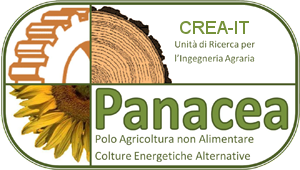Among the alternative biomass crops, Fibre Sorghum is gaining a lot of interest due to its annual cycle and its high drought adaptability. One of the problems related to energy crops like this, is the importance of decreasing production costs and harvest times. In addition, the need to reduce the biomass moisture content in order to decrease the transport costs and allow for storage without fermentative phenomena occurring is a main challenge for the agro-energy chain. The harvesting experiments of the previous years conducted by the means of mower-conditioner, sidedelivery rake and packers, represent the first step for the development of a prototype that solves the difficulties previously encountered. In 2007, Panacea Group conceived and developed a mowing machine that permits the cutting and conditioning of the whole plant by deep cracking of the stems. The results of previous experimental tests conducted with the Panacea prototype have provided interesting results by reducing sun exposure times enough to obtain the right moisture content for the baling, handling and preservation of the product. Within the Bio-energy project, Panacea Group developed a prototype that is able to highly condition Fibre Sorghum and, in collaboration with S.F.I.R. – Società Industriale Romagnola S.P.A. and Co.Pro.B. Italia Zuccheri – have conducted different experimental tests on Fibre Sorghum with different degrees of growth, moisture contents and harvesting times.
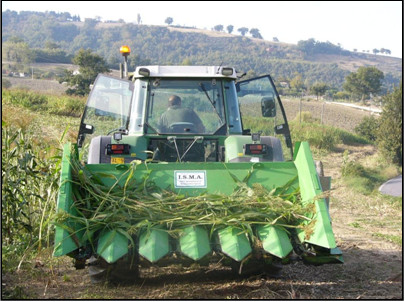 The prototype was designed using the 3D CAD software ThinkDesign Suite (think3, Inc., Bologna, Italy): the first version designed and tested in 2007 possessed a conditioning system consisting in two longitudinal counter-rotating rollers with bars and blades. This machine was rear mounted on a reversible drive tractor, accomplishing, in addition to mowing, a strong conditioning of the whole plant in separate rows. Based on the results obtained in 2007, the conditioning devices were modified and tested in 2008.
The prototype was designed using the 3D CAD software ThinkDesign Suite (think3, Inc., Bologna, Italy): the first version designed and tested in 2007 possessed a conditioning system consisting in two longitudinal counter-rotating rollers with bars and blades. This machine was rear mounted on a reversible drive tractor, accomplishing, in addition to mowing, a strong conditioning of the whole plant in separate rows. Based on the results obtained in 2007, the conditioning devices were modified and tested in 2008.
In 2009, the construction of a precommercial model was commissioned to the Cressoni firm of Volta Mantovana (MN) by means of a call for tenders addressed to agricultural machine manufacturers, so in the spring of 2009 the firm manufactured the prototype according to Panacea’s instructions.
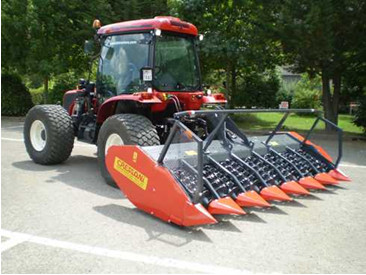 Despite having the same functioning principle as the first prototype (Pari et al., 2009), the pre-commercial mower-conditioning prototype for fiber sorghum produced by Cressoni has a conditioning apparatus lightly different, characterized by a modular structure of seven elements. On the main frame are mounted the conditioner devices in number equal to the rows to be processed in each passage, in a lower position is placed the cutting system. Inside the main frame is located the motion transmission system connected to conditioning devices and the cutting apparatus. Each conditioning device consists of a pair of parallel counter-rotating augers with smaller diameter on the front, so to help the plants infeeding and inversion of the transport direction in the ending portion. The spirals have an outer diameter of 25 mm, 75 mm high coils, pitch of 100 mm and a thickness of 5 mm. The first 5 coils + 3/8 (for a total of 1935°) having only a direction and conveying the product inwards the conditioning system. The end of the screw, with a coil + 3/8 (for a total of 495°) conveys any remaining product to the frontal part, by reversing the direction of rotation, ensuring the total crop conditioning. This system ensures the cleanliness of the conditioner from the accumulation of cut product Two metal parts wing-shaped (height of 75 mm, width of 30 mm and 10 mm thick) are fixed, by welding, along the spirals, alternate between the two screws; these are the main elements dedicated to the processing of the stem, causing alternately bending and tearing of plants. The shafts on which the screws are mounted (diameter 100 mm) have a front and a rear support (shaft total length of 0.9 m) positioned 0.2 meters from each other. The drive force is provided by the PTO of the tractor.
Despite having the same functioning principle as the first prototype (Pari et al., 2009), the pre-commercial mower-conditioning prototype for fiber sorghum produced by Cressoni has a conditioning apparatus lightly different, characterized by a modular structure of seven elements. On the main frame are mounted the conditioner devices in number equal to the rows to be processed in each passage, in a lower position is placed the cutting system. Inside the main frame is located the motion transmission system connected to conditioning devices and the cutting apparatus. Each conditioning device consists of a pair of parallel counter-rotating augers with smaller diameter on the front, so to help the plants infeeding and inversion of the transport direction in the ending portion. The spirals have an outer diameter of 25 mm, 75 mm high coils, pitch of 100 mm and a thickness of 5 mm. The first 5 coils + 3/8 (for a total of 1935°) having only a direction and conveying the product inwards the conditioning system. The end of the screw, with a coil + 3/8 (for a total of 495°) conveys any remaining product to the frontal part, by reversing the direction of rotation, ensuring the total crop conditioning. This system ensures the cleanliness of the conditioner from the accumulation of cut product Two metal parts wing-shaped (height of 75 mm, width of 30 mm and 10 mm thick) are fixed, by welding, along the spirals, alternate between the two screws; these are the main elements dedicated to the processing of the stem, causing alternately bending and tearing of plants. The shafts on which the screws are mounted (diameter 100 mm) have a front and a rear support (shaft total length of 0.9 m) positioned 0.2 meters from each other. The drive force is provided by the PTO of the tractor. 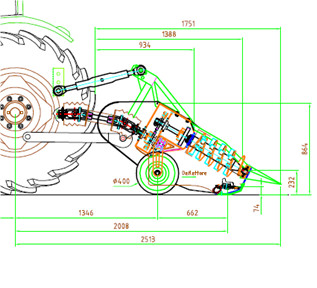 The main transmission is designed as multiple chain (pitch 1”) in oil that operate on gears connected to each conditioning element. Each gear transmits the motion to each module and the phase between two coupled screws is maintained through a pair of gear constantly interlocked, fixed through a key on the screws shafts. The first mower-conditioner prototype was developed in order to work on 7 rows, at a 0,5 m row-spacing, and with a total working width of 3,5 m. Other machines can be realized with different equipments in order to work on a different number of rows and suitable to operate on plants having different rows-spacing. The cutting system consists of an alternate blade with an oil box drive, operating at 1100 rpm. It is constituted by sections of blade fixed to a bar-holder (3.45 m length) by screws and bolts. The counter teeth are made in couples of 56 mm sections. The connection of the cutting system is adjustable, as it can be changed in height respect to the conditioning elements. The machine has a total width of 3.77 m, length of 1.75 m, height of 0.86 m, and the mass is 1400 kg. The first prototype was not provided of devices to maintain a constant cutting height. Thus, subsequently two levelling rear wheels were applied, in order to release a part of the machine weight on the ground by reducing the masses swinging from the tractor. The mower conditioner prototype cuts the plants at ground level and subsequently allow plants conditioning individually, passing the plants through a track within fingers fixed to the screws of each device.
The main transmission is designed as multiple chain (pitch 1”) in oil that operate on gears connected to each conditioning element. Each gear transmits the motion to each module and the phase between two coupled screws is maintained through a pair of gear constantly interlocked, fixed through a key on the screws shafts. The first mower-conditioner prototype was developed in order to work on 7 rows, at a 0,5 m row-spacing, and with a total working width of 3,5 m. Other machines can be realized with different equipments in order to work on a different number of rows and suitable to operate on plants having different rows-spacing. The cutting system consists of an alternate blade with an oil box drive, operating at 1100 rpm. It is constituted by sections of blade fixed to a bar-holder (3.45 m length) by screws and bolts. The counter teeth are made in couples of 56 mm sections. The connection of the cutting system is adjustable, as it can be changed in height respect to the conditioning elements. The machine has a total width of 3.77 m, length of 1.75 m, height of 0.86 m, and the mass is 1400 kg. The first prototype was not provided of devices to maintain a constant cutting height. Thus, subsequently two levelling rear wheels were applied, in order to release a part of the machine weight on the ground by reducing the masses swinging from the tractor. The mower conditioner prototype cuts the plants at ground level and subsequently allow plants conditioning individually, passing the plants through a track within fingers fixed to the screws of each device.
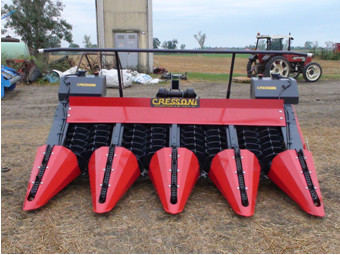 Following the indications obtained from the various experiments conducted by the PANACEA group, the Cressoni company has created, in 2010, the first commercial model of mower conditioner, purchased by the company Coprob in Minerbio (Bo), involved in the conversion of its own factory.
Following the indications obtained from the various experiments conducted by the PANACEA group, the Cressoni company has created, in 2010, the first commercial model of mower conditioner, purchased by the company Coprob in Minerbio (Bo), involved in the conversion of its own factory.
The machine is tractor-mounted and is formed by a main frame on which are fixed the conditioning modules, equal in number to the rows of crop treated. Inferiorly to them is attached the cutting apparatus. The implement is designed to operate on 4 file with inter 0.7 m. 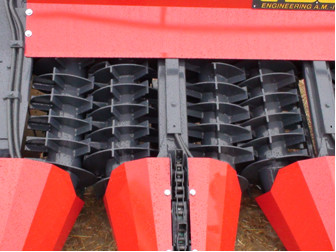 Each conditioning module is composed of a pair of parallel counter-rotating augers. Each auger has a diameter of 352 mm and on each of them there are 6 windings; the latter are soldered on a metal tube 677 mm long and with a diameter of 152 mm. The conditioning effect of the stem due to the presence, along the windings, of contrasting elements, welded in an alternating manner between the two augers. The elements are 36 for auger and are characterized by a height of 100 mm, a width of 30 mm and a thickness of 8 mm. The elements in contrast force the plants within a obliged path alternately creating bendings and lacerations to the same.
Each conditioning module is composed of a pair of parallel counter-rotating augers. Each auger has a diameter of 352 mm and on each of them there are 6 windings; the latter are soldered on a metal tube 677 mm long and with a diameter of 152 mm. The conditioning effect of the stem due to the presence, along the windings, of contrasting elements, welded in an alternating manner between the two augers. The elements are 36 for auger and are characterized by a height of 100 mm, a width of 30 mm and a thickness of 8 mm. The elements in contrast force the plants within a obliged path alternately creating bendings and lacerations to the same.
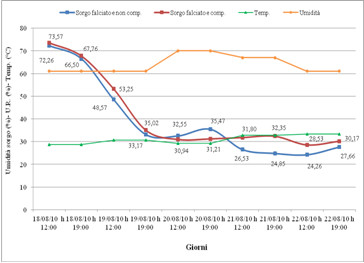 The mower conditioner has proved to be functional purpose for which it was designed and built: conditioning strongly the sorghum plants in order to reach an acceptable time the moisture content suitable for storage.
The mower conditioner has proved to be functional purpose for which it was designed and built: conditioning strongly the sorghum plants in order to reach an acceptable time the moisture content suitable for storage.
They were reduced solar exposure times in the field of mowed plants, allowing you to reach in about 3 days, the minimum percentage of humidity (30%) favorable for harvesting in bales of biomass.
![]() Fiber Sorghum (Sorghum bicolor L.) references
Fiber Sorghum (Sorghum bicolor L.) references
